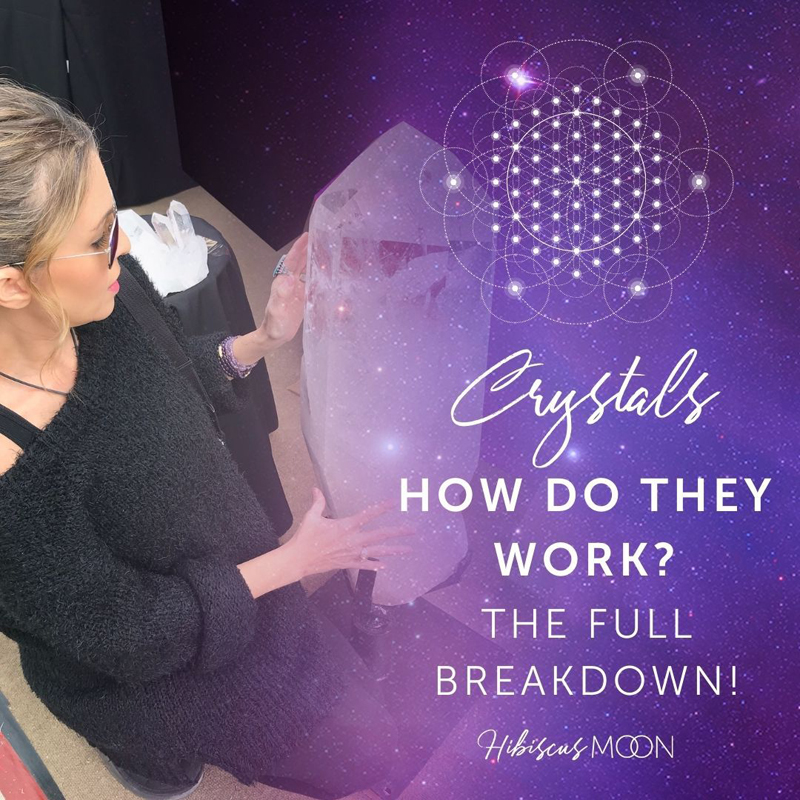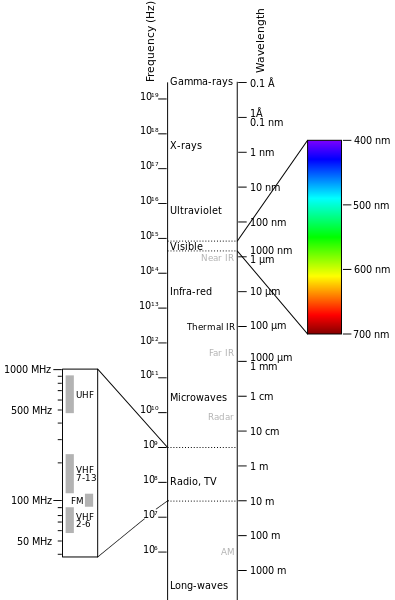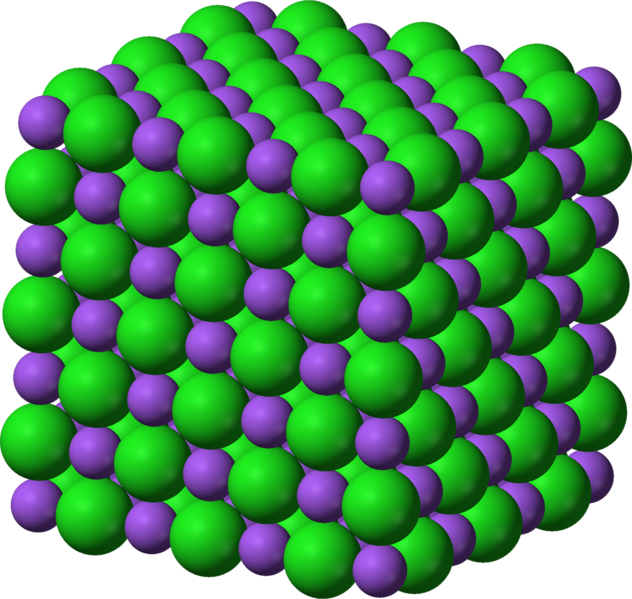More and more I am asked: how crystals work.

Or more specifically I’m frequently asked how they can quickly explain to others how crystals work.
(By the way, this blog post includes a video I filmed a bit ago but I didn’t get the attention it deserved. Every time I share with someone who asks me how crystals work they are so grateful for this explanation. So I’ve added some more info, updates, and info here to go along with it.)
Sorry, but I don’t have a quick explanation. I usually take an entire course to explain it. 😉 However, I could break it down into a couple of blog posts. I know that’s not quick. It’s not the elevator speech you were hoping for but it’s the best I can do.
Crystals have vibrations just like everything else does.
It’s important to keep in mind that our entire physical universe is made up of pure energy and vibration.
LINK: Unexpectedly, many of you wanted to know where you could get a copy of the poster I’m using in the video: here you go. Is that cuz you’re home-schooling your kiddos right now? TIP: you can also get it in white and use it as a dry-erase poster.
How Crystals Work
Einstein determined that energy and matter (technically “mass”) are actually the same thing:
E = mc2
That means energy equals mass (I accidentally said “matter” in the video), and vice versa mass equals energy.
“Mass” is a measure of how much matter there is in something. (
So, everything is made up of pure energy and vibration.
But the vibrations from crystals are very different.
Matter vibrates at different vibrational frequencies. Not just our crystals, all matter — my chair, my desk, you, me, the light… they all have this average resonant frequency. Think of the up and down wave that you used to see in math class that goes up and down, up and down.
Quite some time ago, I coined this the “dominant oscillary rate” and for ease of communication; DOR.
We’re talking vibration here – this sounds woo but this is straight-up physics here.
We as humans are a collection of DORs. So, we’re a collection of frequencies. Our heart has one DOR. Our kidneys have different DORs. Our eyes have a different DOR. Our brain has a different DOR. Each organ, so your heart, your brain, your liver, all the various cells, the DNA right down to the chromosomes and beyond even.
So, we have an average vibrational frequency made up of a collection of varying DORs, and it’s not very stable.
In fact, it’s quite easily influenced by all sorts of things in our environment including statements, thoughts, and emotions; emotions are simply energy, you know. Actually, since we’re all connected to and influenced by everything in our environment, including crystals and stones, our unstable vibrational nature makes it so that absolutely anything can interact with our energy field and leave its mark on us.
So, our frequency can get really out of whack when we experience any type of high amplitude energy; like stress.
Contrast that with a Crystal
A crystal, in contrast, has one DOR. It’s not a collection of different ones. It’s not made of varying organs. It has one DOR and it depends on several things: for instance, the crystal’s specific molecular composition and what elements make up that crystal, its size, and its thickness. Yes, the thickness or size of a crystal will affect the DOR.
Next, its specific color will affect the DOR.

I consider color to be very important because the visible color that we see is just specific light frequencies being reflected back to our eyes. If I’m looking at an amethyst crystal and I see that violet, okay, that’s a very specific vibrational frequency, a specific light frequency on the electromagnetic spectrum. Violet is a higher frequency than red. Red has a longer wavelength; a very specific energy that’s emanating from that crystal.
So, we’ve established that many variables affect the dominant oscillary rate of a crystal.
A crystal ALSO has a very precise fixed, repeating, molecular pattern.
That’s what makes a crystal a crystal. Unlike us, it’s geometrically perfect.

Sodium chloride molecule (salt crystal)…look at that precise crystal structure!
What actually makes a crystal a crystal is its molecular arrangement. If you were able to zoom down in with a scanning electron microscope (that’s the kind of microscope that can see the molecules really, really small) they’re arranged in this fixed regularly repeating geometric pattern.
Not random at all.
It’s the exact opposite of random.
On the other hand, as humans, we are not geometrically perfect. We don’t have that fixed, repeating, geometric, molecular pattern. We’re not crystals – although we do have some liquid crystal and some crystalline structures, we also have quite a bit of randomness. We don’t have this very precise precision to us –as crystals do.
So, since crystals are geometrically perfect at the molecular level, they have the lowest possible state of disorganization because see, most things in our immediate universe tend towards disorganization. Remember that a crystal has one fixed, repeating, geometric, molecular pattern.
Because of that, crystals have the lowest state of entropy.
Entropy is just the tendency to go towards disorder. If someone wasn’t mowing the lawn here every week, I’m in south Florida, the grass would get crazy! If someone wasn’t putting work into the system of the lawn it would tend towards disorder. It would go straight towards chaos/disorder really fast. Crazy and weedy. Right? After a few months, we would be absolutely overgrown by weeds, vines, and bushes. Things tend to rust and tend towards disorder if you don’t put work into the system to keep it maintained and organized. When you put work into a system entropy is not taking over.
Instead, you get the opposite; syntropy; organization, and coherence.
So, we’ve also established that since crystals are so geometrically perfect; crystals have a very low state of entropy. They actually resist disorder.
They have this low state of disorganization and they easily maintain their stability unlike us. Here again – We’re very unstable.
So, these different things play into the stability; DOR, and vibrational frequency of that crystal.
Want to know my list of Top 10 Must-Have Crystals? I’ve got an easy-to-reference free pdf download right here for you. The downloadable pdf includes my original list of Top 10 Must-Have Crystals, plus a list of My Top 10 Advanced Crystals! Just submit your name and best email below and it’ll be delivered straight to your inbox.
Sorry. This download is no longer available.
Signing up for this download will also sub you to my bi-weekly newsletter + my free Sacred Spaces eKit.
Part 2 covers:
- How are the healing properties of a crystal determined?
- Why are we influenced by the energy of crystals?
- What about the programming of a crystal?
So what did you think of How Crystals Work Part 1 so far? Too boring? Too geeky or not GEEKY ENOUGH? Geek on Fleek? Please let me know in the comments below~!
And, of course, you can now check out Part 2 here. 🙂
Crystal Blessings,


Thank you for this. I knew all this info, but this helps a little bit to be able to explain it to others. It is wonderfully thorough and well-organized. Thanks!!!
Thank you, Marlene. It was the best I could do as far as condensing goes. 😉
<3 always great to refresh!!!! Thank you!!
I love how well balanced your posts are. Your writing is amazing, it’s explained throughly, fun, easy to understand yet also with just enough nerdy scientific terms.
Don’t get me wrong I’m a sucker for knowing/learning ALL possible cross-correlating terms, for an all-encompassing explanatory ,descriptive, and definitive language to be able to, in future; describe or explain a concept (mostly for a deeper understanding for my own purposes and experiments) but to explain to others that level understanding with that much crazy rhetoric would just confuse most people! (Which is my problem hahaha) thank you for setting a perfect standard of blended balanced writing to reach the masses, and open their eyes!! Great posts, love everything your about!
[…] How do Crystals work? […]
[…] How do Crystals work? […]